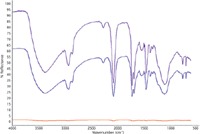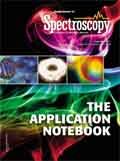Mid-Infrared Reflectivity Measurements of Diffuse Materials
Application Notebook
The approach to infrared measurements of diffusely scattering materials often is dictated by the objective of the analysis. Spectral data from three different mid-infrared reflectance sampling accessories are contrasted.
The approach to infrared measurements of diffusely scattering materials often is dictated by the objective of the analysis. Spectral data from three different mid-infrared reflectance sampling accessories are contrasted.
Infrared analysis of highly scattering or textured samples is often accomplished via diffuse reflectance sampling accessories. Among two of the most popular diffuse reflectance accessories are the confocal ellipsoidal mirror design, which results in only a fraction of the reflected light being collected, and the integrating sphere design (1). The specific accessory used for the measurement will be determined by the information desired. The aim of this application note is to compare mid-infrared spectral data of a diffuse sample obtained by using various reflection accessories.
Experimental Conditions
A powdered coated metal panel was analyzed using the PIKE UpIR™, a diffuse reflection accessory with an ellipsoidal collection mirror, or the PIKE mid-infrared IntegratIR™, a gold-coated integrating sphere equipped with a liquid nitrogen cooled MCT detector. The sampling surface of the UpIR is positioned above the FT-IR making it ideal for analyzing large samples. Additionally, a spectrum was collected using a 10o specular reflection accessory. The background and sample collection time was 20 s, and the resolution was set to 4 cm-1 .
Results
All spectra are shown in Figure 1. The spectrum of the powdered coated sample collected with the 10o specular reflection accessory resulted in reflectivity values near 1% and minimal chemical information is discernable due to the diffuse characteristic of this sample. Only the specular component reflecting at the angle equivalent to the angle of incidence, 10o in this case, is collected. Specular reflection accessories are appropriate for specular samples such as mirrors, optical windows, and coatings on reflective surfaces.

Figure 1: Spectrum of painted panel obtained using an elliptical collection type accessory (shown in purple), an integrating sphere ( shown in blue), and a 10o specular reflection accessory (shown in red).
Chemical information from a high quality spectrum is obtained from the ellipsoidal collection mirror (UpIR) and the integrating sphere accessory. Therefore, either accessory is suitable for this purpose. The reflectivity measurements were different; at 4000 cm-1 65% reflectivity was measured using the integrating sphere while the reflectivity of the sample collected using the UpIR was 93%. However, only the integrating sphere accessory produces reliable reflectivity data because it is able to collect close to the entire available hemispherical (2π steradians) scattered photons.
The integrating sphere has a highly reflective, close to a Lambertian surface, such that the light enters the sphere, bounces around the highly reflective diffuse surface of the sphere wall, and finally impinges upon the detector. In addition to reflectivity measurements as described here, the PIKE IntegratIR may be used for diffuse transmission measurements. Despite the 100 year history of the sphere, new applications are continually developed.
Conclusions
For reflectivity measurements of diffuse samples, using an integrating sphere is preferred, whereas for obtaining only chemical information a ellipsoidal mirror design diffuse reflection accessory is adequate.
References
(1) L.M. Hanssen and K.A. Snail, Handbook of Vibrational Spectroscopy, Chalmers and Griffiths, Eds. (2002).
PIKE Technologies
6125 Cottonwood Drive, Madison, WI 53719
tel. (608) 274-2721; fax (608) 274-0103
Website: www.PIKEtech.com

Thermo Fisher Scientists Highlight the Latest Advances in Process Monitoring with Raman Spectroscopy
April 1st 2025In this exclusive Spectroscopy interview, John Richmond and Tom Dearing of Thermo Fisher Scientific discuss the company’s Raman technology and the latest trends for process monitoring across various applications.
A Seamless Trace Elemental Analysis Prescription for Quality Pharmaceuticals
March 31st 2025Quality assurance and quality control (QA/QC) are essential in pharmaceutical manufacturing to ensure compliance with standards like United States Pharmacopoeia <232> and ICH Q3D, as well as FDA regulations. Reliable and user-friendly testing solutions help QA/QC labs deliver precise trace elemental analyses while meeting throughput demands and data security requirements.